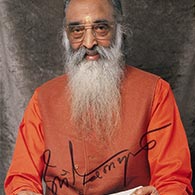DAY 9 – 21st April
Session 1
Satsang on Sri Ram Navami
and Puja
by Swami Swatmananda

Bantu reetikolu, a Telugu composition of Saint Tyagaraja was an appropriate and beautifully rendered invocation. Swamiji started with the thought that it is the name of the Lord which will be with us, all through life and also when we drop the body. Celebrating the birth of Sri Rama, Swamiji spoke on Sri Ram, who had incarnated to destroy all evil forces and to re-establish Dharma.
Swamiji quoted from Tulsi Ramayan, Balakhand. The scriptures define three types of desires.
1. Vitteshna - desire for wealth
2. Lokeshna - desire for fame and glory
3. Putreshna - desire to have one's own children
Dasharatha had fulfilled the first two and wanted his third desire fulfilled. His guru, sage Vasishtha told him to perform Putrakaameshti Yagna and assured him that he would have four children.
Yagna has to be understood from three standpoints.
1. Karma aspect - With a ritual, devatas are invoked. It is not a mechanical act but involves discipline and self-integration. If yagna is performed as per Vedic injunctions, there will surely be positive results.
2. Bhavana aspect - Yagna is selfless work, for which everyone comes together, contributing in whatever way they can. Vasishtha transformed personal desire into samashthi sankalpa, of the whole society.
3. Jnana aspect - From the highest standpoint, everything in this world is pervaded by Brahman alone. Brahman manifests as the sentient and the insentient. Phenomenal forces are worshipped as devatas, water as Ganga Ma, air as Vaayu devata.
If we do our work properly, our mind would get purified and we could work together, to discover the vision of Oneness. Sage Vasishtha made King Dasharatha perform the yagna to understand its deeper significance. Bhagawan was born by a nimmita of the yagna. Dasharatha still thought Him to be his son. Later, when Vishwamitra rishi came to take Bhagawan to protect the yagnas, Dasharatha was reluctant to part with his sons, especially Rama. At the end of the yagna, performed by Rishi Shringa, Agni devata appeared and told Vasishtha that his sankalpa was fulfilled and he would get the desired result.
We need the four qualities - Purushaartha, Guru Kripa, Seva Bhaav and Bhagawan’s Kripa. This brings success and happiness in our personal life. The paayasam was given to Dasharatha for distribution amongst his three wives. He gave half to Kaushalya who symbolises Brahma Vidya. He gave half of the remaining to Kaikeyi who symbolises Karma. He distributed the remaining he amongst Kaushalya and Kaikeyi, who in turn gave it to Sumitra, who symbolises Upasana. Swamiji further explained that Upasana gives us chitta shuddhi, by which one becomes capable of gaining self-knowledge and Karma becomes Karma Yoga.
Swamiji then performed Ram Janma Puja by doing abhisheka and chanting Aditya Hrudayam Stotram and 108 names of Sri Rama. Aarti was performed. Sankalpa was taken, dedicated to health workers all over the world and the armed forces protecting us.
Report by
Sheila Sampat
Chinmaya Prakash Zone
--------------------------------------------------------------------------------------------------------
DAY 9 – 21st April
Session 2
Talk on
Vedantic Symbolism of Ramayana
by Swami Chinmayananda

Ramayana is a Purana, which demonstrates subtle philosophical thought, inscribed in Upanishads. Ramayana is glory of Rama, son of King Dasharatha, one who had controlled the ten chariots - five senses of perception and five senses of action. Rama - Sarve Ramanti iti Rama - One who revels in every form, Atman in the self. Rama was born in Ayodhya. Yuddha means conflict. Ayodhya means where there was no conflict. Where there is no conflict in mind, in that steady mind, Rama will take avatar.
Rama, the Supreme Lord - If he remained in Ayodhya, He cannot serve the world. Therefore, He must meet Sita and get wedded. Sita is Prakriti (matter). Jeeva married Rama, bringing glory. With marriage, one cannot live in Ayodhya. Conflicts are natural.
Forest symbolizes Samsara. Ravana is Dashamukha, antithesis of Dasharatha. He has yielded to the ten senses. He is sensuous, immoral, vulgar, lust-driven, ruthless, cunning, materialist. As long as Sita (jiva) was anchored in constant remembrance of the Lord, she was in permanent bliss. But jiva cannot be in permanent Narayan smruti. Objects of the world will attract.
The golden deer symbolizes worldly sense objects - the impermanent, swift, fleeting pleasures of sense objects. The cravings and agitations of the mind cannot be free until the object is acquired. The moment Sita got distracted by the golden deer, she separated herself from the constant remembrance of the Lord.
Ravana, with bad intentions, presented himself as a sadhu, which symbolised bad intentions wrapped in divine packaging. When the monster of materialism catches the jiva, it is impossible to come out of it. Sita was brought to Lanka, land of Rakshasas, symbolising land of materialism, power, position, status, sensuality and a barbaric world of duality.
Sita, a spiritual seeker being separated from the Lord, suffered due to desires as perceiver, feeler and thinker in Lanka. Ashokavana and the tree symbolized that constant remembrance of Rama makes the jiva feel no agony (a-shoka) despite all challenging moments. Indifferent to the sorrows and worries of life, Sita sat steadily remembering Rama. Regrets wipe out vasanas when one contemplates on the glory of the Lord. When the seeker refuses to co-operate with materialism, desire cannot overpower it.
Monkeys symbolise the mind. Thoughts are chanchalatva and astheeratva - restlessness and instability. Vali symbolized lust, which one has to destroy from behind. Monkeys were under the leadership of Sugreeva, who symbolised reins over lust. Hanuman symbolizes Bhakti and Sevak-bhaav. Rama-setu (bridge) is contemplation between the limited and unlimited, time bound and time less. When Rama killed Ravana, Sita’s illusion and delusion ended, as avidya was destroyed.
Report by
Mukesh G. Trivedi
Chinmaya Prakash Zone


